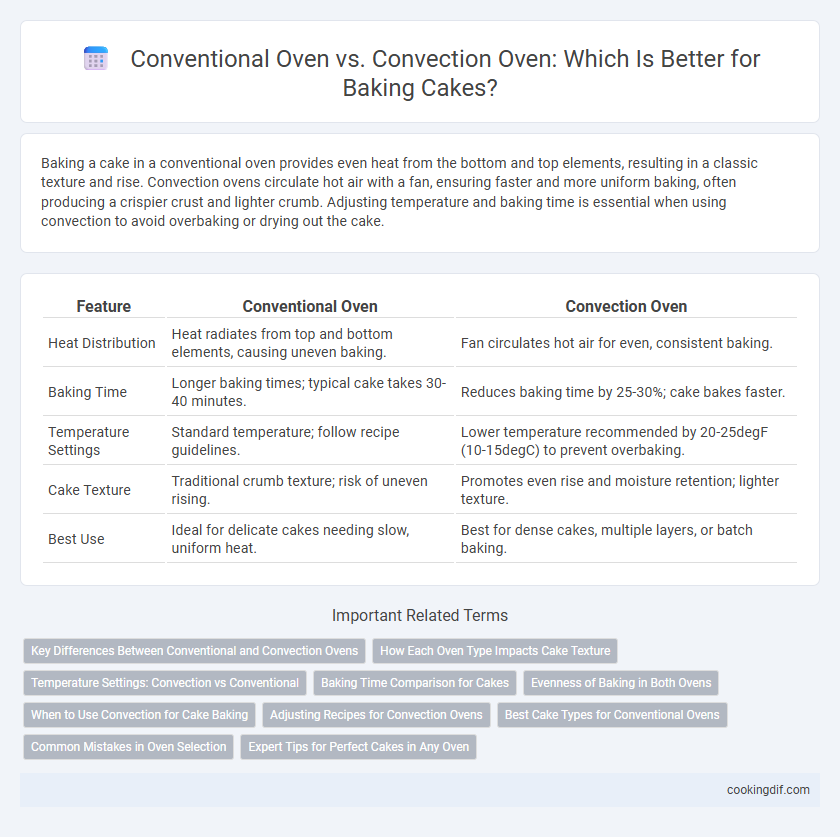Baking a cake in a conventional oven provides even heat from the bottom and top elements, resulting in a classic texture and rise. Convection ovens circulate hot air with a fan, ensuring faster and more uniform baking, often producing a crispier crust and lighter crumb. Adjusting temperature and baking time is essential when using convection to avoid overbaking or drying out the cake.
Table of Comparison
| Feature | Conventional Oven | Convection Oven |
|---|---|---|
| Heat Distribution | Heat radiates from top and bottom elements, causing uneven baking. | Fan circulates hot air for even, consistent baking. |
| Baking Time | Longer baking times; typical cake takes 30-40 minutes. | Reduces baking time by 25-30%; cake bakes faster. |
| Temperature Settings | Standard temperature; follow recipe guidelines. | Lower temperature recommended by 20-25degF (10-15degC) to prevent overbaking. |
| Cake Texture | Traditional crumb texture; risk of uneven rising. | Promotes even rise and moisture retention; lighter texture. |
| Best Use | Ideal for delicate cakes needing slow, uniform heat. | Best for dense cakes, multiple layers, or batch baking. |
Key Differences Between Conventional and Convection Ovens
Conventional ovens use static heat from the top and bottom elements, resulting in slower and uneven baking, which can cause cakes to have inconsistent textures. Convection ovens employ a fan to circulate hot air evenly around the cake, promoting faster baking times and more uniform browning and rising. This key difference makes convection ovens ideal for achieving moist, evenly baked cakes with crisp edges.
How Each Oven Type Impacts Cake Texture
Conventional ovens use radiant heat from the top and bottom elements, which can cause uneven baking and denser cake textures due to slower heat circulation. Convection ovens feature a fan that circulates hot air evenly, promoting consistent baking and producing lighter, fluffier cakes with a more uniform crumb. Optimal cake texture in convection ovens results from faster heat transfer, reducing baking time and preventing dry edges.
Temperature Settings: Convection vs Conventional
Conventional ovens typically require higher temperature settings, around 350degF (175degC), for baking cakes, while convection ovens use a lower temperature, usually 25degF (14degC) less due to their efficient hot air circulation. The consistent heat distribution in convection ovens results in more even browning and faster baking times, reducing the risk of overbaking edges or undercooked centers in cakes. Adjusting temperature settings according to the oven type is crucial for achieving optimal texture and rise in cake baking.
Baking Time Comparison for Cakes
Convection ovens typically reduce cake baking time by 25% compared to conventional ovens due to their efficient hot air circulation, which ensures even heat distribution. Conventional ovens generally require longer baking times, often leading to uneven cooking or browning if not monitored closely. Choosing a convection oven optimizes baking time and consistency, producing cakes with uniform texture and color faster.
Evenness of Baking in Both Ovens
Convection ovens use a fan to circulate hot air, resulting in more even heat distribution and consistent cake baking, reducing hot spots and uneven rising. Conventional ovens tend to have uneven temperature zones, which can cause parts of the cake to bake faster than others, leading to uneven texture and browning. Bakers seeking uniform crumb and color often prefer convection ovens for their ability to maintain steady heat across the cake's surface.
When to Use Convection for Cake Baking
Convection ovens circulate hot air for even baking, making them ideal for cookies, pies, and roasting but can cause cakes to rise unevenly or form a crust too quickly. Use convection baking for cakes only when a recipe specifies it or when baking multiple cakes simultaneously on different racks to ensure consistent heat distribution. For delicate cakes like chiffon or sponge, conventional ovens typically yield better texture and rise due to gentler, radiant heat.
Adjusting Recipes for Convection Ovens
Convection ovens circulate hot air evenly, requiring cake recipes to reduce baking temperature by 25degF (about 15degC) and shorten baking time by 25%. This adjustment prevents overbaking and ensures moist, tender cakes with even browning. Monitoring cake doneness frequently and using toothpick tests help achieve optimal results in convection baking.
Best Cake Types for Conventional Ovens
Conventional ovens provide consistent, even heat that is ideal for baking dense, delicate cakes like pound cakes, fruit cakes, and cheesecakes, as this steady temperature prevents cracking and uneven rising. Cakes with longer baking times, such as sponge cakes and layered butter cakes, benefit from the traditional heat distribution of conventional ovens to ensure moisture retention and a tender crumb. For bakers aiming for a classic texture and appearance, conventional ovens remain the preferred choice for these cake types.
Common Mistakes in Oven Selection
Conventional ovens often cause uneven baking due to inconsistent heat distribution, leading to dry edges and undercooked centers in cakes. Common mistakes include ignoring the convection setting that circulates hot air, which can promote even browning and reduce baking time. Selecting the wrong oven type without adjusting baking temperature or time frequently results in cakes that are overbaked or insufficiently risen.
Expert Tips for Perfect Cakes in Any Oven
Conventional ovens provide steady, radiant heat ideal for traditional cake recipes, while convection ovens use a fan to circulate hot air, resulting in faster, more even baking and crispier edges. Expert bakers recommend lowering the temperature by 25degF when using a convection oven to prevent overbaking and monitoring the cake closely for doneness. Understanding these differences ensures perfectly baked cakes with consistent texture and moist crumb regardless of oven type.
Conventional oven vs Convection oven for cake baking Infographic

 cookingdif.com
cookingdif.com